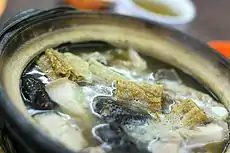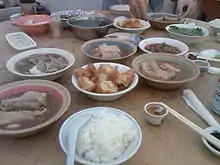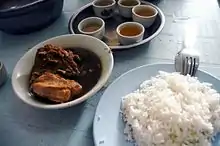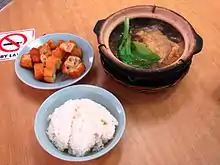Bak kut teh
Bak kut teh (also spelt bah kut teh and abbreviated BKT; Chinese: 肉骨茶; Pe̍h-ōe-jī: Bah-kut-tê, Teochew Pe̍h-uē-jī: nêg8-gug4-dê5) is a pork rib dish cooked in broth popularly served in Malaysia and Singapore where there is a predominant Hoklo and Teochew community.
 A closeup of bak kut teh | |
| Place of origin | Fujian, China[1][2]
Klang, Malaysia (Hokkien version)[3][4] Singapore (Teochew version)[5][6] |
|---|---|
| Region or state | Hokkien- and Teochew-speaking areas of Malaysia, Singapore |
| Associated cuisine | Malaysia, Singapore |
| Main ingredients | pork ribs, complex broth of herbs and spices (including star anise, cinnamon, cloves, dang gui, fennel seeds and garlic) |
| Variations | Hokkien and Teochew |
| Bak kut teh | |||||||||||||||
|---|---|---|---|---|---|---|---|---|---|---|---|---|---|---|---|
| Chinese | 肉骨茶 | ||||||||||||||
| Hokkien POJ | Bah-kut-tê | ||||||||||||||
| Literal meaning | meat bone tea | ||||||||||||||
| |||||||||||||||
The name literally translates from the Hokkien dialect as "meat bone tea", and at its simplest, consists of pork ribs simmered in a broth of herbs and spices (including star anise, cinnamon, cloves, dong quai, fennel seeds and garlic) for hours.[7][8] Despite its name, there is in fact no tea in the dish itself; the name refers to a strong oolong Chinese tea which is usually served alongside the soup in the belief that it dilutes or dissolves the copious amount of fat consumed in this pork-laden dish.
However, additional ingredients may include offal, varieties of mushroom, choy sum, and pieces of dried tofu or fried tofu puffs. Additional Chinese herbs may include yu zhu (玉竹, rhizome of Solomon's seal) and ju zhi (buckthorn fruit), which give the soup a sweeter, slightly stronger flavor. Light and dark soy sauce are also added to the soup during cooking, with varying amounts depending on the variant – the Teochew's version is lighter than the Hokkiens'. The dish can be garnished with chopped coriander or green onions and a sprinkling of fried shallots.
In Malaysia, it is often served with strips of fried dough called you char kway (Chinese: 油炸鬼/粿). Soy sauce (usually dark soy sauce, but light soy sauce is also offered sometimes) is preferred as a condiment, with which chopped chilli padi (Bird's eyes chili) and minced garlic is taken together. Tea of various kinds, for example the Tieguanyin (鐵觀音, 铁观音) variety which is popular in the Klang Valley area of Malaysia, is also usually served in the belief that it dilutes or dissolves the copious amount of fat consumed in this pork-laden dish.
In Singapore, similarly the Teochew variant dish is served with a side of youtiao cut into small pieces, meant to be dipped into the soup of the dish before consumption. Braised pig trotters are also an option that can be ordered as a side together with the dish and dark soy sauce with chilli padi is preferred as a condiment. Tea, prepared in a kung fu tea ceremony is also served in restaurants specialising in the dish.
Bak kut teh is usually eaten for breakfast or lunch. The Hokkien and Teochew are traditionally tea-drinking cultures and this aspect runs deep in their cuisines.
History

Bak kut teh is commonly consumed in both Malaysia and Singapore.[3] The origin of bak kut teh is unclear, but it is believed to have been brought over from Fujian, China[4][1][2] and to have derived from the Fujianese dish known as niu pai.[9] In Malaysia, the dish is popularly associated with Klang, where the locals believe it to be the place of origin of bak kut teh.[10] There are a number of claims for the invention of the dish; one claimed that a local sinseh (a Chinese physician) invented the dish in the 1930s,[11] while another claimed he brought the recipe from his hometown in Fujian, China, in the 1940s.[2] The dish is also claimed to have been invented in Port Klang for coolies working at the port to supplement their meagre diet and as a tonic to boost their health in the early 20th century.[11] The dish was popular among early Chinese immigrants, many of whom had also come from Fujian.
The Teochew variant was developed in Singapore and was sold along areas located beside the Singapore River, specifically in Clarke Quay and River Valley after the end of World War II.[5] It is believed that the Singaporean version of the dish had at least been around since 1938, with evidence from Pek Sin Choon, a tea supplier which had been supplying tea to a bak kut teh stall since 1938.[6] Established in 1925,[12] owners of Pek Sin Choon claims that it had been supplying tea to bak kut teh stalls since its founding, but the business records were lost during World War II and the oldest preserved record by the business dates back to 1938.[6] By the 1960s, bak kut teh had become a popular street fare in Singapore. Certain business has been focused mainly on serving this dish, and developed their business from humble pushcart into a restaurant chain.
The Chinese word bak (肉), which means "meat" (or more specifically pork), is the vernacular pronunciation in Hokkien, but not in Teochew (which pronounced it as nek), suggesting an original Hokkien root.[13]
The question of its origin has been the subject of a dispute between Malaysia and Singapore; in 2009, the tourism minister of Malaysia, Ng Yen Yen, claimed that bak kut teh is a dish of Malaysian origin, and that neighbouring countries had "hijacked" many of Malaysia's original dishes.[14]
Varieties


There are numerous variants of bak kut teh with its cooking style closely influenced by the prevailing Chinese enclave of a certain geographical location.
There are three main types of bak kut teh.
- The Teochew style, which is light in colour but uses more pepper and garlic in the soup.
- The Hoklo (Hokkien), uses a variety of herbs and soy sauce creating a more fragrant, textured and darker soup.
- The Cantonese, with a soup-drinking culture, add medicinal herbs as well to create a stronger flavoured soup.
The main visual difference between the Hokkien and Teochew version of bak kut teh is that the Hokkiens use more dark soy sauce and thus the soup base is characteristically darker in colour.[15]
In addition, a dry form of bak kut teh has also recently become increasingly popular within Malaysia, especially in Klang town. Although called dry, the broth is in fact reduced to a thicker gravy, to which other ingredients such as wolfberries, dried dates, dried chillies and dried squid are added. Unlike the original rib soup, the dry version has a tangier, sharper taste and is more akin to a herbal stew than the classical broth. It is often recommended locally in Malaysia as an excellent hangover cure.
In Malaysia, a less fatty variation of bak kut teh made with chicken instead of pork is called chik kut teh.[16] It also serves as a halal version of the dish catered to Muslims, whose religion forbids them to consume pork.[17]
Bak kut teh is popular among the Chinese Indonesian community in the Riau Islands, Indonesia.[18]
Vegetarian bak kut teh also can be found in Malaysia. Instead of using pork or chicken, oyster mushroom is used.
Malaysian national record
On 22 November 2008, the Malaysian Klang Chinese Chamber of Commerce and Industry (KCCCI) collaborated with five bak kut teh sellers in Klang to cook the world's biggest bowl of the Hokkien variant of bak kut teh. The bowl was 182.88 cm in diameter and 91.44 cm in height, and contained 500 kg of pork, 450 kg of soup and 50 kg of herbal medicine, and has been listed in the Malaysian Book of Record.[19]
See also
References
- Damien Lim. "Bak kut teh". National Library Board of Singapore.
- WANI MUTHIAH. "The man who put Teh in bak kut teh". TheStar newspaper.
- Yoshino, Kosaku (2010). "Malaysian Cuisine: A Case of Neglected Culinary Globalization" (PDF). Globalization, Food and Social Identities in the Asia Pacific Region. Tokyo: Sophia University Institute of Comparative Culture: 4. Archived from the original (PDF) on 2 May 2014. Retrieved 8 July 2014.
- Chua Lam (5 April 2011). chua lam's gourmet journey in Malaysia (PDF). G.F. Publishing(M) Pte Ltd. p. 26. ISBN 9789675381119.
- Temasek Polytechnic (15 July 2015). Singapore Hawker Classics Unveiled: Decoding 25 Favourite Dishes. Marshall Cavendish International (Asia) Pte Ltd. pp. 93–96. ISBN 9789814677868.
- "Singapore and Malaysia have claimed these 4 dishes. We get to the bottom of the food fights - CNA". Channel News Asia. 24 April 2023. Retrieved 15 May 2023.
- Vivian. "BAK KUT TEH". Retrieved 2 April 2021.
- Grêlé D, Raimbault L, Chng N. Discover Singapore on Foot. Select Publishing, 2007. page 158.
- "Tracing the origins of bak kut teh | The Star". www.thestar.com.my. Retrieved 10 March 2021.
- Su-Lyn Tan; Mark Tay (2003). Malaysia & Singapore. Lonely Planet. p. 140. ISBN 9781740593700.
- Florence A. Samy (23 September 2009). "No intention to patent local food, Dr Ng says". The Star. Archived from the original on 20 December 2016. Retrieved 15 September 2015.
- "History - Pek Sin Choon Pte Ltd - 白新春茶庄". Pek Sin Choon. Retrieved 15 May 2023.
- Leslie Tay (20 July 2011). "g Huat Bak Kut Teh Restoran: The Origins of Bak Kut Teh continued…".
- "Malaysian food being hijacked". The Sydney Morning Herald. 18 September 2009.
- Naleeza Ebrahim; Yaw Yan Yee (31 July 2010). Not Just a Food Guide: Singapore. Marshall Cavendish International (Asia) Pte Ltd. pp. 153–154. ISBN 978-9812329226.
- Chinese Food in Kuala Lumpur
- Malaysiakini (9 December 2009). "'Halal' bak kut teh has been around for ages". MalaysiaKini.com.
- "Resep Masakan : "Bak Kut Teh 肉骨茶 ala Teochew". web.budaya-tionghoa.net. Archived from the original on 20 January 2021. Retrieved 21 January 2020.
- B.I. (23 November 2008). "World's biggest bowl of Bak Kut Teh in Malaysia". XinHuaNet. Archived from the original on 25 December 2008.